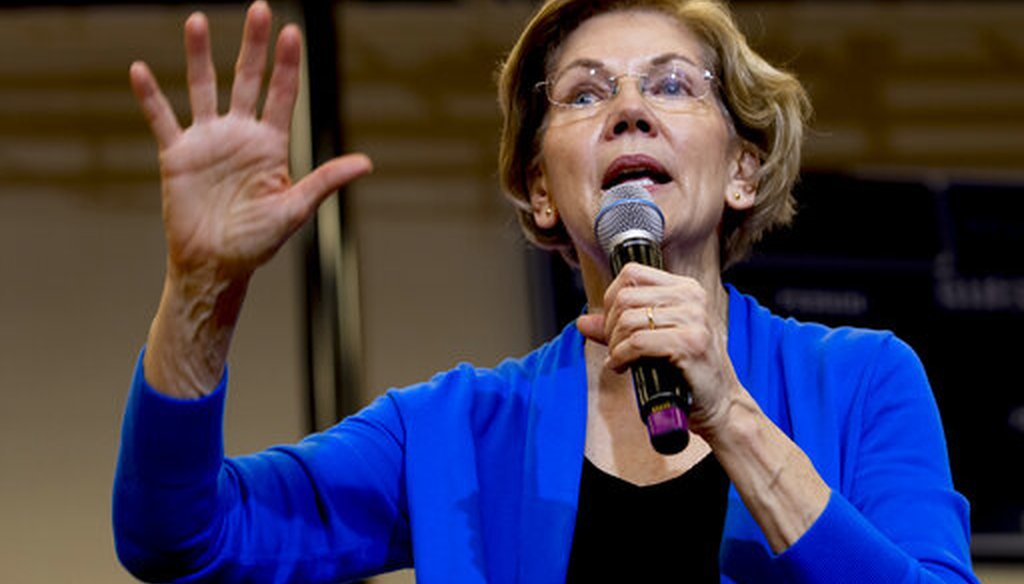Stand up for the facts!
Our only agenda is to publish the truth so you can be an informed participant in democracy.
We need your help.
I would like to contribute

Democratic presidential candidate Elizabeth Warren at a campaign stop in Nashua, N.H., on Feb. 5, 2020. (AP)
DERRY, N.H. — Democratic presidential candidate Elizabeth Warren infused her closing argument before the New Hampshire primary with an embrace of President Barack Obama’s legacy.
Volunteers at her Get Out the Vote rally at a music hall in Derry handed out signs saying "hope over fear," invoking the signature word of Obama’s 2008 campaign. And Warren’s newest TV ads feature Obama’s voice praising Warren as a champion of the middle class.
While her "Medicare for All" health care plan has faced criticism as effectively tearing down Obama’s Affordable Care Act, Warren aimed to put those fears to rest.
"As president, I will defend the Affordable Care Act and strengthen the Affordable Care Act," Warren said.
PolitiFact is traveling through New Hampshire this week to fact-check Democratic candidates ahead of the state’s Feb. 11 primary.
RELATED: See our fact-checks from New Hampshire of Joe Biden, Bernie Sanders and Andrew Yang
We fact-checked several of Warren’s statements about carbon emissions, drug overdose deaths and bad bank behavior.
"Three industries produce 70% of our carbon output in the United States."
That’s imprecise, and we’ve rated a similar claim from Warren at Half True. The U.S. Environmental Protection Agency’s page on the sources of greenhouse gas emissions shows that three sectors — transportation, electricity production and industry — account for 78% of the American total.
But those are activities, not industries in themselves. Transportation, the biggest of the three, includes the cars people drive and the flights they take for business and pleasure.
The focus on industry shifts attention away from the broader ways that energy consumption is woven into the fabric of American life, said John Reilly, the co-director of MIT’s Joint Program on the Science and Policy of Global Change.
"About 193 people died today from an overdose from addiction."
This is in line with federal data.
In 2017, there were 70,237 drug overdose deaths in the United States, according to the Centers for Disease Control and Prevention. About 68% involved some type of opioid, whether natural, synthetic or semisynthetic.
When you break these statistics down into deaths per day, there were approximately 192 drug overdose deaths each day on average in 2017. Of those 192 deaths, about 130 each day involved an opioid.
"The president has the power but just hasn’t used it to be able to bring down the cost of commonly used prescription drugs, and I'm going to use this for EpiPens, for insulin, for HIV-AIDS drugs."
This is accurate, but there are limits. Current law says the government can intervene to take over patents without a company’s permission if the price is too high. The government can then create competition to bring down prices by importing those products from abroad or manufacturing them. The original manufacturer can sue for damages but cannot stop Washington from breaking the patent.
Existing law gives Washington special authority to take over production of a critical drug, but only when it holds all the patents because it funded the research that led to its development. That applies to relatively few prescription drugs.
"By the early 2000s in America, home mortgages had become so dangerous and so complex they had a one in five chance of costing a family their home through foreclosure."
This is correct. Complex mortgages, mainly subprime and adjustable rate mortgages, grew in the first half of the decade and accounted for a huge share of defaults.
A 2007 study of home loans in Massachusetts by the Federal Reserve Bank of Boston found that "homeownerships that begin with a subprime purchase mortgage end up in foreclosure almost 20% of the time." That was just for Massachusetts, but a housing expert told us it was in line for the rest of the country.
A separate analysis from the Chicago Federal Reserve found default rates of over 35% for subprime loans made in 2006. And a major federal report on the foreclosure crisis noted that adjustable rate mortgages accounted for over half of foreclosure starts in 2008.
Says the Consumer Financial Protection Bureau "has already forced the banks to return more than $12 billion directly to people they cheated."
The number is about right. (See the bureau’s website.)
Warren said the money came from banks, but it was more than that. The bureau took action against credit card companies, student loan servicers, mortgage companies, and other financial players, too.
Our Sources
See links in story.























































